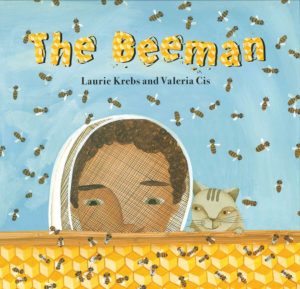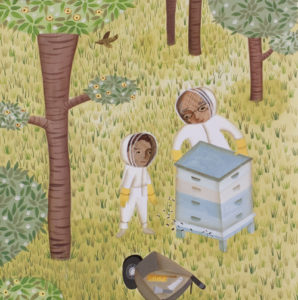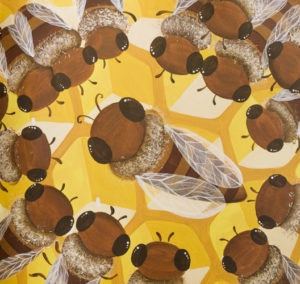At April WVBA meeting I challenged beekeepers to join the 2015 AG IN THE CLASSROOM (AITC) Literacy Project designed to help better improve literacy of Kindergarten through 6th grade students along with their knowledge of agriculture. Oregon is generating a buzz this year by offering as a component of their Literacy Project a chance to read to students the delightful book The Beeman and provide a beekeeping/bee pollination lesson.
The OR AITC Literacy Project, now in its 8th year, recruits and then trains volunteers to visit local schools to read to students in grades K-4. In 2014 over 600 volunteers, read to 18,172 students across the state. The book reading and activity take about 45 minutes. The Literacy Project runs from early March through into June but the resources developed to support the Project will remain on the AITC website and can be easily downloaded http://aitc.oregonstate.edu/index.htm
 The Book the Beeman
The Book the Beeman
The Beeman is a delightful story of a boy and his grandfather, the Beeman. The story describes the amazing and complex life of bees, how they help pollinate plants, and how honey is collected by beekeepers. It was chosen because it is ag accurate, it has received several awards and endorsements (most recently as 2014 American Farm Bureau Book of the Year, its lovely artwork (by Valerie Cis) and for its easy-flowing, rhyming dialogue of author Laurie Krebs. I had the pleasure of fact-checking the bee information for Laurie.
Here are three sample pages (illustrations below courtesy of Barefoot Books)
“Here is the beehive, where all the bees sleep/tucked into a box called a shallow or deep/and then placed on a stand/by the Beeman.”

“Here is the queen bee, who does her job well/and lays eggs in a six-sided cell/She’s the heart of the hive/says the Beeman”

”Here’s the extractor, its ‘clickety-clack/removing the honey from frames on its rack/and filling up jars/for the Beeman”

In addition to being a wonderful story, the book includes additional information about beekeeping, pollination, honey, bee dancing and even a honey-apple muffin recipe. Volunteers are encouraged after reading the story to read the section on pollination. Beekeepers who volunteer (so far 15 beekeeper volunteers have visited classooms) have an opportunity to take an observation hive, bee hive components, their coveralls or other bee-related items to show the students. GloryBee of Eugene has donated flavored honey straws to distribute to students.
Following the reading, a fun, interactive activity Busy Bee can be done to emphasize that bees play an important role in agriculture by recognizing the impact pollinators have on the food that we consume. This lesson teaches students about cross-pollination. 3 students become a bee hive, and 15 others become apple, blueberry and flower growers, with the remainder being worker bees. The “worker bees” “fly” from the hive to one of the farmers, picking up pollen (chalk on the duplicated plant sheets) with cotton swabs (hind leg substitutes) and then fly back to the hive to deposit their pollen (chalk) at the hive.
OR AITC Executive Director Jessica Budge offers an instructive video on the lesson and coordinates Volunteers, matching schools with volunteers. Volunteer have the backup kit and information to help explain the cross-pollination being illustrated. Oregon State Honey Bee Lab technician Carolyn Breece helped the AG in the classroom program develop the lesson and activity and actually was the first to “test” the program in early March. The lesson aligns with Oregon State Standards.
It is a great opportunity to read a receptive audience with a very doable, interesting and active learning opportunity. I encourage beekeepers to check it out and help bring this message to our next generation of potential beekeepers.
